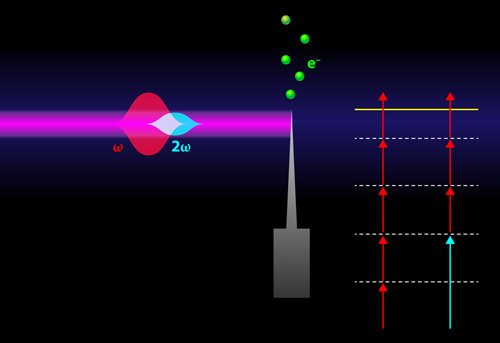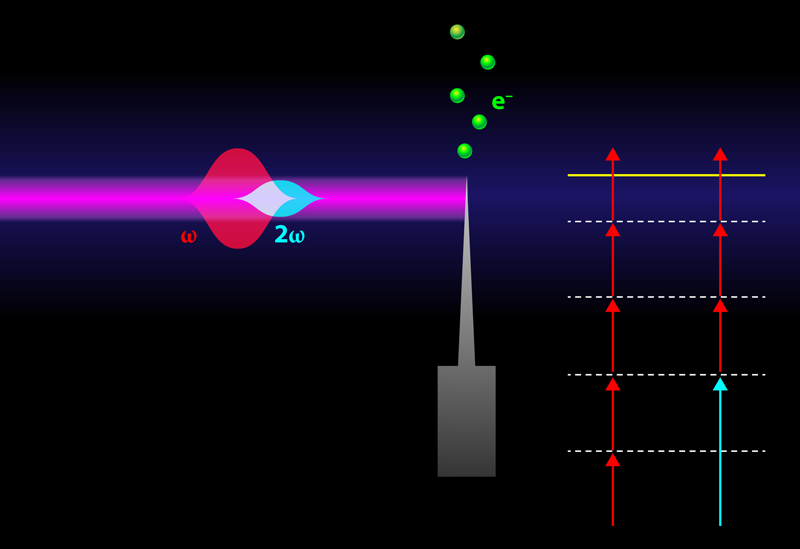An Ultrafast Switch for Electron Emission
The ability to control electron pulses on the femtosecond time scale is at the heart of several ambitious research endeavors, ranging from ultrafast electron microscopes [1, 2] to tabletop particle accelerators and intense x-ray sources [3]. A first approach to making an ultrafast electron source, still widely used today, has been to illuminate a flat metal surface with a short laser pulse that initiates electron emission from the surface. The smaller the size of an electron source, however, the better the quality of the electron beam, measured in terms of how well it can be collimated, how small it can be focused with a given lens, etc. Michael Förster from Friedrich-Alexander University, Germany, and colleagues have demonstrated a new mechanism for controlling ultrafast electron emission from a nanotip [4]. The team utilizes two laser pulses at different frequencies that together produce an interference effect between excited electrons in the nanotip. Because of the interference, the phase difference between the two lasers becomes a knob that can be used to adjust the amount of electron emission.
Ultrafast electron emission from nanotips was first studied about ten years ago [5, 6]. Nanotips are essentially metal wires that have been sharpened to a fine point—the radius of curvature of such a tip can be smaller than tens of nanometers. The sharpness of the tip implies that a modest applied voltage can generate electric field strengths of GV/m, sufficient to cause electrons to tunnel out of the metal. However, electron emission can also be triggered by laser light. In one scenario, a small bias voltage—too small to induce tunneling—is applied to a nanotip, but electron emission occurs when the nanotip is exposed to an ultrafast laser pulse. Electrons are excited by one or more photons from the pulse, and those that have sufficient energy can escape the metal. Emission can also occur in highly nonlinear processes using a high-intensity laser beam. Here, the emission process can be loosely thought of as tunneling due to the strong electric field applied by the laser, and it leads to electron emission in spikes that are shorter than the optical cycle.
Förster and colleagues [4] have demonstrated a new mechanism for controlling ultrafast electron emission from a nanotip. They are able to switch laser-induced photoemission on and off using two pulses: one strong pulse at a fundamental frequency and a much weaker laser pulse at twice that frequency (second harmonic). The switching effect is a classic example of coherent control [7]: the second harmonic drives a second photoemission pathway whose final state has the same energy as the original one (see Fig. 1). The first pathway involves an electron absorbing five fundamental photons, with each “absorption step” in that pathway corresponding to an intermediate state. The second pathway has the electron absorb one second harmonic photon and three fundamental photons. Both pathways have the same final state, so they can interfere either constructively or destructively depending on the phase of the second harmonic relative to the fundamental frequency. Constructive interference quadruples the electron emission (relative to the fundamental-only case), whereas destructive interference suppresses the emission almost entirely. The relative difference—or so-called “visibility”—between the constructive and destructive interference is 94%, which is remarkable considering that the intensity of the second harmonic control field is only 2% that of the fundamental. Shifting the phase of this relatively weak second harmonic by (or, equivalently, delaying it by about 1.3 fs) is enough to completely switch electron emission on or off.
The observed interference has a higher visibility than that of any other reported coherent control photoemission, including two-color photoionization, where two lasers of different frequency are used to ionize atoms or molecules in the gas phase [8]. It is perhaps a little surprising that a solid-state system with closely spaced energy levels and fast decoherence should show a cleaner response than gas-phase systems with fewer degrees of freedom. But the experiment in this case is aided by the small size of the tungsten tip apex, which at 10 nm is substantially smaller than the wavelength and spot size of the focused laser beam. The upshot is that the electrons in the tip are exposed to fairly uniform light fields. By contrast, for a gas-phase experiment, atoms or molecules are located randomly in the optical beams and see variable ratios of intensities of the fundamental and second harmonic light as well as spatially varying phase differences. Both of these effects reduce the visibility of the interference [8].
Förster et al. have built an extraordinarily sensitive switch, but how fast is it? In principle, the electron emission should turn off just as quickly as one can change the phase of the second harmonic from its constructive to its destructive value. However, if electrons linger for a relatively long time in the intermediate states, then the emission could briefly continue from these populated states—even as destructive interference prevents them from being refilled. The authors do not know precisely how long electrons linger in the intermediate states, but they are able to place an upper bound of 10 fs on the intermediate state lifetime based on the laser pulse duration. This implies that the switching occurs at least on a scale of 10 fs, but it is intriguing to consider the possibility that the response is even faster, and that the coherent control mechanism could be used to shape the emitted electron pulses on the femtosecond time scale.
Previously, the same group has observed nanotip emission in a highly nonlinear regime where the maximum electric field of the laser is strong enough that the time for an electron to tunnel through the potential barrier at the metal-vacuum interface is comparable to the period of the laser [9]. In this regime, electrons are emitted in spikes that are shorter than the period of the laser. In their latest work, Förster et al. are working at lower intensities, where the emission is better described by a multiphoton process. Does the dramatic switching of the electron emission by the second harmonic’s phase persist as the laser intensity ramps up to the highly nonlinear regime? There are hints that it might. Even at the intensities used in their experiment, there is measurable emission that comes from absorption of multiple photons above the threshold of five photons. Förster et al. meticulously measured the dependence of this higher-order emission on the phase of the second harmonic light relative to the fundamental, finding identical phase dependence for all of the orders. This suggests that it will be possible to switch all photon orders together at higher intensities, which could give researchers a knob for switching an individual femtosecond emission spike on or off. But we’ll have to wait to see results of such an experiment.
This research is published in Physical Review Letters.
References
- R. J. D. Miller, “Mapping Atomic Motions with Ultrabright Electrons: The Chemists' Gedanken Experiment Enters the Lab Frame,” Annu. Rev. Phys. Chem. 65, 583 (2014).
- C. Kealhofer, W. Schneider, D. Ehberger, A. Ryabov, F. Krausz, and P. Baum, “All-Optical Control and Metrology of Electron Pulses,” Science 352, 429 (2016).
- R. J. England et al., “Dielectric Laser Accelerators,” Rev. Mod. Phys. 86, 1337 (2014).
- M. Förster, T. Paschen, M. Krüger, C. Lemell, G. Wachter, F. Libisch, T. Madlener, J. Burgdörfer, and P. Hommelhoff, “Two-Color Coherent Control of Femtosecond Above-Threshold Photoemission from a Tungsten Nanotip,” Phys. Rev. Lett. 117, 217601 (2016).
- P. Hommelhoff, Y. Sortais, A. Aghajani-Talesh, and M. A. Kasevich, “Field Emission Tip as a Nanometer Source of Free Electron Femtosecond Pulses,” Phys. Rev. Lett. 96, 077401 (2006).
- C. Ropers, D. R. Solli, C. P. Schulz, C. Lienau, and T. Elsaesser, “Localized Multiphoton Emission of Femtosecond Electron Pulses from Metal Nanotips,” Phys. Rev. Lett. 98, 043907 (2007).
- M. Shapiro and P. Brumer, “Control of Unimolecular Reactions Using Coherent Light,” Chem. Phys. Lett. 126, 541 (1986).
- P. Ackermann, A. Scharf, and T. Halfmann, “Strong Quantum Interferences in Frequency Up-Conversion Towards Short Vacuum-Ultraviolet Radiation Pulses,” Phys. Rev. A 89, 063804 (2014).
- M. Krüger, M. Schenk, and P. Hommelhoff, “Attosecond Control of Electrons Emitted from a Nanoscale Metal Tip,” Nature 475, 78 (2011).





